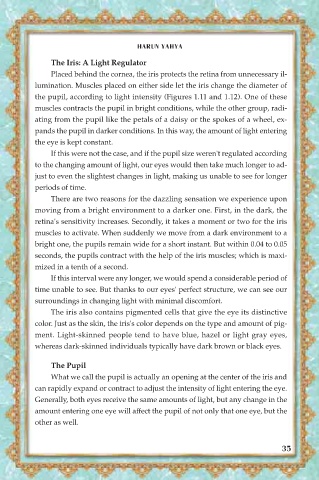Page 37 - Miracle in the Eye
P. 37
HARUN YAHYA
The Iris: A Light Regulator
Placed behind the cornea, the iris protects the retina from unnecessary il-
lumination. Muscles placed on either side let the iris change the diameter of
the pupil, according to light intensity (Figures 1.11 and 1.12). One of these
muscles contracts the pupil in bright conditions, while the other group, radi-
ating from the pupil like the petals of a daisy or the spokes of a wheel, ex-
pands the pupil in darker conditions. In this way, the amount of light entering
the eye is kept constant.
If this were not the case, and if the pupil size weren't regulated according
to the changing amount of light, our eyes would then take much longer to ad-
just to even the slightest changes in light, making us unable to see for longer
periods of time.
There are two reasons for the dazzling sensation we experience upon
moving from a bright environment to a darker one. First, in the dark, the
retina's sensitivity increases. Secondly, it takes a moment or two for the iris
muscles to activate. When suddenly we move from a dark environment to a
bright one, the pupils remain wide for a short instant. But within 0.04 to 0.05
seconds, the pupils contract with the help of the iris muscles; which is maxi-
mized in a tenth of a second.
If this interval were any longer, we would spend a considerable period of
time unable to see. But thanks to our eyes' perfect structure, we can see our
surroundings in changing light with minimal discomfort.
The iris also contains pigmented cells that give the eye its distinctive
color. Just as the skin, the iris's color depends on the type and amount of pig-
ment. Light-skinned people tend to have blue, hazel or light gray eyes,
whereas dark-skinned individuals typically have dark brown or black eyes.
The Pupil
What we call the pupil is actually an opening at the center of the iris and
can rapidly expand or contract to adjust the intensity of light entering the eye.
Generally, both eyes receive the same amounts of light, but any change in the
amount entering one eye will affect the pupil of not only that one eye, but the
other as well.
35

